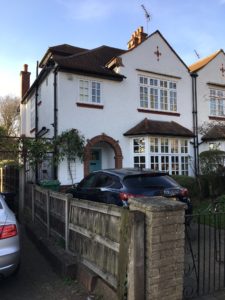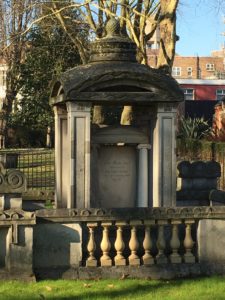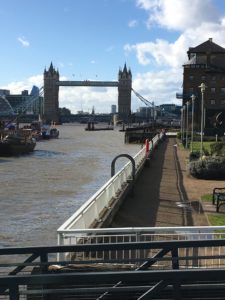2nd April 2019 London,UK
Mad Day Out

This week is English Tourism Week, an annual celebration of the people, places and experiences which make holidays in England so great. I thought I would mark the occasion by blogging about my attempt to retrace an English journey which took place more than fifty years ago.
The Beatles, the most famous band in the world, took what has become known as their Mad Day Out around London on Sunday 28 July 1968. It was actually a hard-working photo session, with the commission going to war photographer Don McCullin, but attempting to trace the path of the Mad Day Out today does give something of a feeling of madness, both in the way the itinerary criss-crosses London, apparently haphazardly, and in the oddity of the selected locations, largely eschewing the famous sights and instead choosing a miscellaneous group of corners of the capital. Though here again, method may have underlain apparent madness, in selecting places where large crowds were unlikely to gather quickly to spoil the shots.
First off was Thomson House on Gray’s Inn Road, for some interiors. Running from King’s Cross Station down towards Chancery Lane, Gray’s Inn Road is today a rather mixed thoroughfare, the Inn of Court at its southern end not typical of the road as a whole. Thomson House no longer exits, but the media associations with the street remain through the ITV/ITN building at no 200, a place whose exterior seems surprisingly unwilling to advertise its occupants.
And then a lurch right across central London to the old Mercury Theatre, at 2 Ladbroke Road in Notting Hill. This is an achingly affluent residential area. The Mercury Theatre was housed in a squat sandstone building next to the large Pentecostal Kensington Temple, founded as the Horbury Chapel in 1849, which appears to have been the old church hall. It proudly sports not one but two blue plaques, the first recording that the Mercury Theatre stood here from 1931-87. The vision of playwright Ashley Dukes, it was specialised in poetic dramas, holding the London premieres of T S Eliot’s Murder in the Cathedral and Genet’s The Maids. The second celebrates the place as “the birthplace of British ballet”, the home of the Ballet Rambert, run by Dukes’ wife, Marie Rambert. The photos taken in 1968 were interiors, featuring a jam session around a piano and some posing with a parrot, who had been brought in for the event. Don McCullin misremembered the place as a “strange community hall somewhere in the East End.” It is now private housing, though there is still a statue of Mercury on the roof.

The third location is the most cantankerous of all. The Beatles headed up to Highgate Cemetery in order to be photographed next to Marx’s grave. But they didn’t actually make it inside the cemetery, with the photoshoot held in front of some ordinary houses on nearby Swain’s Lane. They posed on a bench, which no longer exists, outside no 79, and then stood outside no 59, where the semi-detached house still looks much as it did back in 1968.

The next stop was Old Street roundabout. With the aid of a plank of wood, the band climbed on top of a concrete block in the traffic island, adopting a series of amusing poses, which presumably startled the passing drivers. It is all rather difficult to envisage today. Old Street roundabout is awaiting redevelopment. The Magic Roundabout bar which used to inhabit the centre of the roundabout, and did much to preserve the memory of the Beatles’ connections with the place, is now closed. When I visited, the roundabout was a hard-to-interpret mix of metal arches supporting advertising hoardings, chipboard and ventilators for the underground station below.
The fifth location was the cemetery and gardens around St Pancras Old Church. For those trying to retrace the itinerary, this is the most straightforwardly touristic of all the Mad Day Out locations. To the north of St Pancras station, approached along a road running beside the station that passes what seems an eternal line of idling taxis, it is a tranquil spot. Reportedly an ancient site of Christian worship, reputedly dating to the 4th century and named after a Roman saint, the building was reworked in the Victorian period and has a beautiful arched entrance, in front of which the Beatles were photographed.
But most of the photos were taken in the gardens, which feature an array of interesting monuments. Most prominent among these is the Burdett-Coutts Memorial Sundial, a decorated gothic-style column atop a tired wedding-cake structure. It was unveiled in 1879 by Baroness Burdett-Coutts, the charity-giving “Queen of the Poor” of London, and is inscribed with the names of those whose graves were obliterated when part of the churchyard had to make way for progress, in the name of the Midland Railway.
Another monument in the gardens linked to that event is the “Hardy Tree”, surrounded by an encircling circular hedge. Headstones moved to accommodate the railway were propped up against this tree, whose roots have now grown around them. It is named after Thomas Hardy, in recognition of the rather unenviable role of the future author, then an architecture student, in organising the exhumation of those buried in the railway’s path.
Between these two monuments a third is worthy of note: the Soane Mausoleum, designed by architect Sir John Soane, and now serving as his tomb, together with those of his wife and son. The central cubic tombstone is encased by a canopy supported by four Ionic columns, the canopy serving as an inspiration for the design by Giles Gilbert Scott of the iconic red British telephone box.

The Beatles were photographed in various places around the gardens. On a bench. Near a drinking fountain, a gift from William Thornton Esq, Senior Church Warden of St Pancras, 22 August 1877. Sitting on the grass near the Soane Mausoleum, next to a “please keep off the grass” sign which no longer exists. Nor, it seems, does the prohibition. And in a hollyhock-filled flowerbed. Some of these photos feature the backdrop of the red-brick buildings around the garden, including St Pancras Hospital and the Coroner’s Court. The final photos here had the Beatles mingling with the crowd standing behind railings separating the church from the gardens. The railings are still there. The image was used on the sleeve of both the Red Album and Blue Album compilations.
Near the Burdett-Coutts Memorial Sundial is a bench of pale wood, bearing a plaque reading: “John, George, Paul and Ringo from The Beatles Pop Group sat here during their “Mad Day Out”. Sunday 28th of July 1968.” I love that “Pop Group”.
The sixth location required a big switch eastwards to Wapping. The area has changed heavily since the late 1960s, when it was part of the declining London docklands. The first site used here, the corner of Wapping High Street and Sampson Street, is now a mini-roundabout overlooked by expensive high-end blocks of flats in sand-coloured bricks. But amongst these modern redevelopments sits the historical Pierhead area, the original lock entrance to the London docks, flanked by two lines of Georgian houses built in the early 19th century for officials of the London Docks Company. The Pierhead was filled in and now accommodates a railed garden for residents of these historic houses, who clearly value their privacy. “Private road. No access to river. No parking” say the signs at the entrance to the little cobbled streets.
The Pierhead was the scene of some of the odder photos taken in 1968, with Paul McCartney stripped down to the waist and John Lennon pretending to be dead. A well-known view of the Beatles standing beside the Thames with Tower Bridge in the background appears to be taken from the Pierhead, but since the garden is off limits now a similar shot can be taken from the Thames Path, alongside the modern Cinnabar Wharf development at 24-28 Wapping High Street.

The final location, well into the evening of that Sunday in 1968, was a geodesic dome in the garden of Paul McCartney’s home at 7 Cavendish Avenue, St John’s Wood. He still lives there, a smart detached house behind a high wooden gate. A blue plaque records that Billy Fury lived just down the road. It is a short walk from here to Abbey Road, the world’s first purpose-built recording studio when it was opened in 1931 by Sir Edward Elgar and the LSO. Next to the studio is London’s most peculiar tourist attraction, the pedestrian crossing featured on the Abbey Road album, where visitors play out a bizarre game of judging the patience of local motorists as they adopt Beatles-esque poses on the crossing. At the Abbey Road souvenir shop next to the studio tourists can complete the experience by purchasing an “I Walked the Crossing” T-shirt.

So what do we learn from tracing the route of the Mad Day Out more than half a century on? It speaks about both continuity and change in one of the world’s great cities, with some locations unrecognisable, others barely different from those of 1968. And it speaks of the application of the most famous band in the world whose itinerary, even on a “Mad Day”, leaves the tourist trying to follow it quite exhausted. Happy English Tourism Week!
Thanks for this post.I need more details for about that?